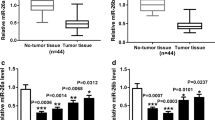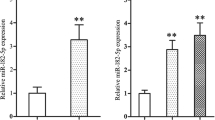Abstract
Tongue squamous cell carcinoma (TSCC) is a common malignancy with aggressive biological behaviors. Mitochondrial fission regulator 1 (MTFR1), is aberrantly expressed in head and neck squamous cell carcinoma (HNSC), but its role in TSCC remains unclear. We aimed to explore the role of MTFR1 in TSCC. The expression of long non-coding RNA small nucleolar RNA host gene 1 (SNHG1), microRNA-194-5p and MTFR1 in TSCC cells was measured by RT-qPCR. Luciferase reporter assay and RNA pull down assay were applied to confirm the binding capacity between miR-194-5p and SNHG1 (or MTFR1). TSCC cell invasion and migration were accessed by Transwell assays. The protein levels of MTFR1 and epithelial‐mesenchymal transition (EMT) markers were examined by western blot. MTFR1 had high expression level in TSCC. MTFR1 knockdown inhibited transforming growth factor β1 (TGFβ1)-induced EMT, migration and invasion of TSCC cells in vitro. MiR-194-5p targeted MTFR1 and negatively regulated its expression. In addition, SNHG1 upregulated the expression of MTFR1 by binding with miR-194-5p. Importantly, SNHG1 promoted EMT, invasion and migration of TSCC cells by upregulating MTFR1. SNHG1/miR-194-5p/MTFR1 axis promotes TGFβ1-induced EMT, migration and invasion of cells in TSCC, which could be potential targets for treating TSCC patients.





Similar content being viewed by others
References
Ni, C., Jiang, W., Wang, Z., Wang, Z., Zhang, J., Zheng, X., Liu, Z., Ou, H., Jiang, T., Liang, W., Wu, F., Li, Q., Hou, Y., Yang, Q., Guo, B., Liu, S., Li, S., Li, S., Yang, E., … Zhao, C. (2020). LncRNA-AC006129.1 reactivates a SOCS3-mediated anti-inflammatory response through DNA methylation-mediated CIC downregulation in schizophrenia. Molecular Psychiatry. https://doi.org/10.1038/s41380-020-0662-3
Bray, F., Ferlay, J., Soerjomataram, I., Siegel, R. L., Torre, L. A., & Jemal, A. (2018). Global cancer statistics 2018: GLOBOCAN estimates of incidence and mortality worldwide for 36 cancers in 185 countries. CA: A Cancer Journal for Clinicians, 68(6), 394–424. https://doi.org/10.3322/caac.21492
Sun, L., Liang, J., Wang, Q., Li, Z., Du, Y., & Xu, X. (2016). MicroRNA-137 suppresses tongue squamous carcinoma cell proliferation, migration and invasion. Cell Proliferation, 49(5), 628–635. https://doi.org/10.1111/cpr.12287
Bagan, J., Sarrion, G., & Jimenez, Y. (2010). Oral cancer: clinical features. Oral Oncology, 46(6), 414–417. https://doi.org/10.1016/j.oraloncology.2010.03.009
Ng, J. H., Iyer, N. G., Tan, M. H., & Edgren, G. (2017). Changing epidemiology of oral squamous cell carcinoma of the tongue: A global study. Head & Neck, 39(2), 297–304. https://doi.org/10.1002/hed.24589
Wang, C., Liu, X., Huang, H., Ma, H., Cai, W., Hou, J., Huang, L., Dai, Y., Yu, T., & Zhou, X. (2012). Deregulation of Snai2 is associated with metastasis and poor prognosis in tongue squamous cell carcinoma. International Journal of Cancer, 130(10), 2249–2258. https://doi.org/10.1002/ijc.26226
Miyazono, K., Ehata, S., & Koinuma DJUjoms,. (2012). Tumor-promoting functions of transforming growth factor-β in progression of cancer. Upsala Journal of Medical Science, 117(2), 143–152. https://doi.org/10.3109/03009734.2011.638729
Kalluri, R., & Weinberg, R. (2009). The basics of epithelial-mesenchymal transition. Journal of Clinical Investigation, 119(6), 1420–1428. https://doi.org/10.1172/jci39104
Zhang, T., Liang, L., Liu, X., Wu, J., Su, K., Chen, J., & Zheng, Q. (2019). LncRNA UCA1/miR-124 axis modulates TGFβ1-induced epithelial-mesenchymal transition and invasion of tongue cancer cells through JAG1/Notch signaling. Journal of Cellular Biochemistry, 120(6), 10495–10504. https://doi.org/10.1002/jcb.28334
Gan, R. H., Wei, H., Xie, J., Zheng, D. P., Luo, E. L., Huang, X. Y., Xie, J., Zhao, Y., Ding, L. C., Su, B. H., Lin, L. S., Zheng, D. L., & Lu, Y. G. (2018). Notch1 regulates tongue cancer cells proliferation, apoptosis and invasion. Cell Cycle (Georgetown, TX), 17(2), 216–224. https://doi.org/10.1080/15384101.2017.1395534
Reddy, R., Khora, S., & Suresh, A. (2019). Molecular prognosticators in clinically and pathologically distinct cohorts of head and neck squamous cell carcinoma—A meta-analysis approach. PLoS ONE. https://doi.org/10.1371/journal.pone.0218989
Sanada, H., Seki, N., Mizuno, K., Misono, S., Uchida, A., Yamada, Y., Moriya, S., Kikkawa, N., Machida, K., Kumamoto, T., Suetsugu, T., & Inoue, H. (2019). Involvement of dual strands of miR-143 (miR-143–5p and miR-143–3p) and their target oncogenes in the molecular pathogenesis of lung adenocarcinoma. International Journal of Molecular Sciences. https://doi.org/10.3390/ijms20184482
Garzon, R., Calin, G. A., & Croce, C. M. (2009). MicroRNAs in cancer. Annual Review of Medicine, 60, 167–179. https://doi.org/10.1146/annurev.med.59.053006.104707
Jiao, D., Liu, Y., & Tian, Z. (2019). microRNA-493 inhibits tongue squamous cell carcinoma oncogenicity via directly targeting HMGA2. OncoTargets and Therapy, 12, 6947–6959. https://doi.org/10.2147/ott.S210567
Shi, B., Yan, W., Liu, G., & Guo, Y. (2018). MicroRNA-488 inhibits tongue squamous carcinoma cell invasion and EMT by directly targeting ATF3. Cellular & Molecular Biology Letters, 23, 28. https://doi.org/10.1186/s11658-018-0094-0
Wang, F., Ji, X., Wang, J., Ma, X., Yang, Y., Zuo, J., & Cui, J. (2020). LncRNA PVT1 enhances proliferation and cisplatin resistance via regulating miR-194-5p/HIF1a Axis in oral squamous cell carcinoma. OncoTargets and Therapy, 13, 243–252. https://doi.org/10.2147/ott.S232405
Dong, P., Kaneuchi, M., Watari, H., Hamada, J., Sudo, S., Ju, J., & Sakuragi, N. (2011). MicroRNA-194 inhibits epithelial to mesenchymal transition of endometrial cancer cells by targeting oncogene BMI-1. Molecular Cancer, 10, 99. https://doi.org/10.1186/1476-4598-10-99
Meng, Z., Fu, X., Chen, X., Zeng, S., Tian, Y., Jove, R., Xu, R., & Huang, W. (2010). miR-194 is a marker of hepatic epithelial cells and suppresses metastasis of liver cancer cells in mice. Hepatology (Baltimore, MD), 52(6), 2148–2157. https://doi.org/10.1002/hep.23915
Salmena, L., Poliseno, L., Tay, Y., Kats, L., & Pandolfi, P. P. (2011). A ceRNA hypothesis: The Rosetta Stone of a hidden RNA language? Cell, 146(3), 353–358. https://doi.org/10.1016/j.cell.2011.07.014
Jadhav, K. B., & Gupta, N. (2013). Clinicopathological prognostic implicators of oral squamous cell carcinoma: Need to understand and revise. North American Journal of Medical Sciences, 5(12), 671–679. https://doi.org/10.4103/1947-2714.123239
Thomas, G. R., Nadiminti, H., & Regalado, J. (2005). Molecular predictors of clinical outcome in patients with head and neck squamous cell carcinoma. International Journal of Experimental Pathology, 86(6), 347–363. https://doi.org/10.1111/j.0959-9673.2005.00447.x
Gupta, S., Kushwaha, V. S., Verma, S., Khan, H., Bhatt, M. L., Husain, N., Negi, M. P., Bhosale, V. V., & Ghatak, A. (2016). Understanding molecular markers in recurrent oral squamous cell carcinoma treated with chemoradiation. Heliyon. https://doi.org/10.1016/j.heliyon.2016.e00206
Guo, L., Lu, X., Zheng, L., Liu, X., & Hu, M. (2016). Association of long non-coding RNA HOTAIR polymorphisms with cervical cancer risk in a chinese population. PLoS ONE, 11(7), e0160039. https://doi.org/10.1371/journal.pone.0160039
Chen, C., Chen, Q., Wu, J., & Zou, H. (2021). H3K27ac-induced FOXC2-AS1 accelerates tongue squamous cell carcinoma by upregulating E2F3. Journal of Oral Pathology & Medicine. https://doi.org/10.1111/jop.13232
Zhao, R., Wang, S., Tan, L., Li, H., Liu, J., & Zhang, S. (2021). IGFL2-AS1 facilitates tongue squamous cell carcinoma progression via Wnt/β-catenin signaling pathway. Oral Diseases. https://doi.org/10.1111/odi.13935
Liu, M., Liu, Q., Fan, S., Su, F., Jiang, C., Cai, G., Wang, Y., Liao, G., Lei, X., Chen, W., Bi, J., Cheng, W., Zhao, L., Ruan, Y., & Li, J. (2021). LncRNA LTSCCAT promotes tongue squamous cell carcinoma metastasis via targeting the miR-103a-2-5p/SMYD3/TWIST1 axis. Cell Death & Disease, 12(2), 144. https://doi.org/10.1038/s41419-021-03415-2
Ge, P., Cao, L., Zheng, M., Yao, Y., Wang, W., & Chen, X. (2021). LncRNA SNHG1 contributes to the cisplatin resistance and progression of NSCLC via miR-330–5p/DCLK1 axis. Experimental and Molecular Pathology. https://doi.org/10.1016/j.yexmp.2021.104633
Guo, C., Li, X., Xie, J., Liu, D., Geng, J., Ye, L., Yan, Y., Yao, X., & Luo, M. (2021). Long noncoding RNA SNHG1 activates autophagy and promotes cell invasion in bladder cancer. Frontiers in Oncology. https://doi.org/10.3389/fonc.2021.660551
Meng, F., Liu, J., Lu, T., Zang, L., Wang, J., He, Q., & Zhou, A. (2021). SNHG1 knockdown upregulates miR-376a and downregulates FOXK1/Snail axis to prevent tumor growth and metastasis in HCC. Molecular Therapy Oncolytics, 21, 264–277. https://doi.org/10.1016/j.omto.2021.02.002
Liu, J., Zhao, C., Yang, S., & Dong, C. (2020). LncRNA SNHG1 promotes the development of oral cavity cancer via regulating the miR-421/HMGB2 axis. Molecular and Cellular Biology, 66(8), 14–19.
Aiello, N., Brabletz, T., Kang, Y., Nieto, M., Weinberg, R., & Stanger, B. J. N. (2017). Upholding a role for EMT in pancreatic cancer metastasis. nature, 547(7661), E7–E8. https://doi.org/10.1038/nature22963
Kamitani, S., Yamauchi, Y., Kawasaki, S., Takami, K., Takizawa, H., Nagase, T., & Kohyama, T. (2011). Simultaneous stimulation with TGF-β1 and TNF-α induces epithelial mesenchymal transition in bronchial epithelial cells. International Archives of Allergy and Immunology, 155(2), 119–128. https://doi.org/10.1159/000318854
Leemans, C. R., Braakhuis, B. J., & Brakenhoff, R. H. (2011). The molecular biology of head and neck cancer. Nature Reviews Cancer, 11(1), 9–22. https://doi.org/10.1038/nrc2982
Huang, H. C., Hu, C. H., Tang, M. C., Wang, W. S., Chen, P. M., & Su, Y. (2007). Thymosin beta4 triggers an epithelial-mesenchymal transition in colorectal carcinoma by upregulating integrin-linked kinase. Oncogene, 26(19), 2781–2790. https://doi.org/10.1038/sj.onc.1210078
Gjerdrum, C., Tiron, C., Høiby, T., Stefansson, I., Haugen, H., Sandal, T., Collett, K., Li, S., McCormack, E., Gjertsen, B. T., Micklem, D. R., Akslen, L. A., Glackin, C., & Lorens, J. B. (2010). Axl is an essential epithelial-to-mesenchymal transition-induced regulator of breast cancer metastasis and patient survival. Proceedings of the National Academy of Sciences of the United States of America, 107(3), 1124–1129. https://doi.org/10.1073/pnas.0909333107
Song, Y., Washington, M. K., & Crawford, H. C. (2010). Loss of FOXA1/2 is essential for the epithelial-to-mesenchymal transition in pancreatic cancer. Cancer Research, 70(5), 2115–2125. https://doi.org/10.1158/0008-5472.Can-09-2979
Lee, J., Choi, J. H., & Joo, C. K. (2013). TGF-β1 regulates cell fate during epithelial-mesenchymal transition by upregulating survivin. Cell death & disease, 4(7), e714. https://doi.org/10.1038/cddis.2013.244
O’Connor, J. W., & Gomez, E. W. (2013). Cell adhesion and shape regulate TGF-beta1-induced epithelial-myofibroblast transition via MRTF-A signaling. PLoS ONE, 8(12), e83188. https://doi.org/10.1371/journal.pone.0083188
Zhang, T. H., Liang, L. Z., Liu, X. L., Wu, J. N., Su, K., Chen, J. Y., & Zheng, Q. Y. (2019). LncRNA UCA1/miR-124 axis modulates TGFβ1-induced epithelial-mesenchymal transition and invasion of tongue cancer cells through JAG1/Notch signaling. Journal of Cellular Biochemistry, 120(6), 10495–10504. https://doi.org/10.1002/jcb.28334
Zhou, R., Zhang, E., Sun, Q., Ye, Z., Liu, J., Zhou, D., & Tang, Y. (2019). Integrated analysis of lncRNA-miRNA-mRNA ceRNA network in squamous cell carcinoma of tongue. BMC Cancer, 19(1), 779. https://doi.org/10.1186/s12885-019-5983-8
Fan, S., Chen, W., Lv, X., Tang, Q., Sun, L., Liu, B., Zhong, J., Lin, Z., Wang, Y., Li, Q., Yu, X., Zhang, H., Li, Y., Wen, B., Zhang, Z., Chen, W., & Li, J. (2015). miR-483–5p determines mitochondrial fission and cisplatin sensitivity in tongue squamous cell carcinoma by targeting FIS1. Cancer Letters, 362(2), 183–191. https://doi.org/10.1016/j.canlet.2015.03.045
Wong, T., Liu, X., Wong, B., Ng, R., Yuen, A., & Wei, W. I. (2008). Mature miR-184 as potential oncogenic microRNA of squamous cell carcinoma of tongue. Clinical Cancer Research, 14(9), 2588–2592. https://doi.org/10.1158/1078-0432.Ccr-07-0666
Wu, X., Gong, Z., Sun, L., Ma, L., & Wang, Q. (2017). MicroRNA-802 plays a tumour suppressive role in tongue squamous cell carcinoma through directly targeting MAP2K4. Cell Proliferation. https://doi.org/10.1111/cpr.12336
Chen, X., Su, X., Zhu, C., & Zhou, J. (2019). Knockdown of hsa_circ_0023028 inhibits cell proliferation, migration, and invasion in laryngeal cancer by sponging miR-194-5p. Bioscience Reports. https://doi.org/10.1042/bsr20190177
Qu, F., Wang, L., Wang, C., Yu, L., Zhao, K., & Zhong, H. (2021). Circular RNA circ_0006168 enhances Taxol resistance in esophageal squamous cell carcinoma by regulating miR-194–5p/JMJD1C axis. Cancer Cell International, 21(1), 273. https://doi.org/10.1186/s12935-021-01984-y
Xin, Y., Li, Z., Shen, J., Chan, M. T., & Wu, W. K. (2016). CCAT1: A pivotal oncogenic long non-coding RNA in human cancers. Cell Proliferation, 49(3), 255–260. https://doi.org/10.1111/cpr.12252
Chen, Y., Sheng, H., Deng, F., & Cai, L. (2021). Downregulation of the long noncoding RNA SNHG1 inhibits tumor cell migration and invasion by sponging miR-195 through targeting Cdc42 in oesophageal cancer. The Kaohsiung Journal of Medical Sciences, 37(3), 181–191. https://doi.org/10.1002/kjm2.12318
Lan, X., & Liu, X. (2019). LncRNA SNHG1 functions as a ceRNA to antagonize the effect of miR-145a-5p on the down-regulation of NUAK1 in nasopharyngeal carcinoma cell. Journal of Cellular and Molecular Medicine, 23(4), 2351–2361. https://doi.org/10.1111/jcmm.13497
Zhao, Y., Shi, J., Zhao, Y., & Lu, Z. (2021). SNHG1/miR-186/FUT8 regulates cell migration and invasion in oral squamous cell carcinoma. Oral Diseases. https://doi.org/10.1111/odi.13878
Author information
Authors and Affiliations
Corresponding author
Ethics declarations
Conflict of interest
The authors declare that they have no conflict of interest.
Additional information
Publisher's Note
Springer Nature remains neutral with regard to jurisdictional claims in published maps and institutional affiliations.
Supplementary Information
Below is the link to the electronic supplementary material.
Rights and permissions
About this article
Cite this article
Jia, Y., Chen, X., Zhao, D. et al. SNHG1/miR-194-5p/MTFR1 Axis Promotes TGFβ1-Induced EMT, Migration and Invasion of Tongue Squamous Cell Carcinoma Cells. Mol Biotechnol 64, 780–790 (2022). https://doi.org/10.1007/s12033-021-00445-1
Received:
Accepted:
Published:
Issue Date:
DOI: https://doi.org/10.1007/s12033-021-00445-1




